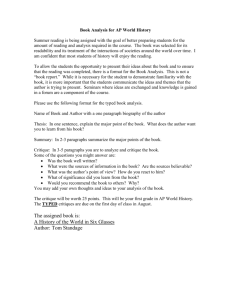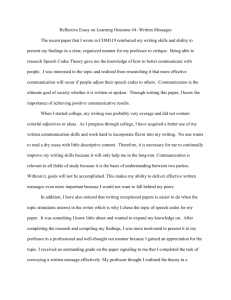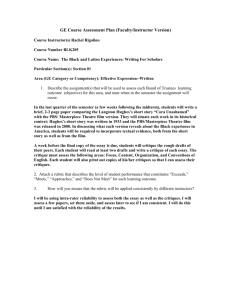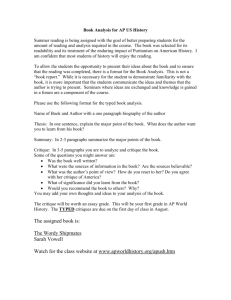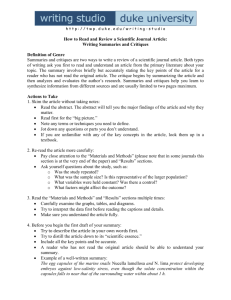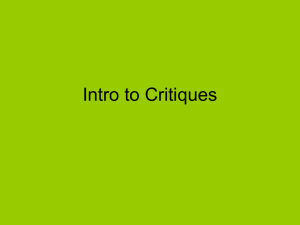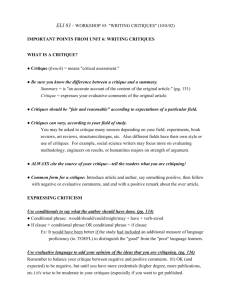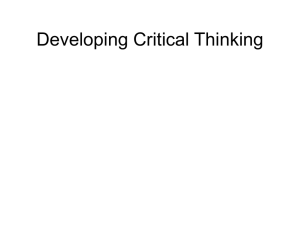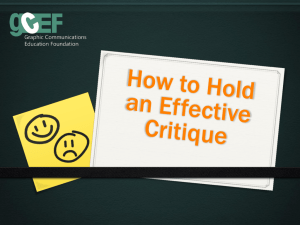Evaluation across Disciplinary Groups in University Student Writing: The Critique... Family as Texts and Text
advertisement
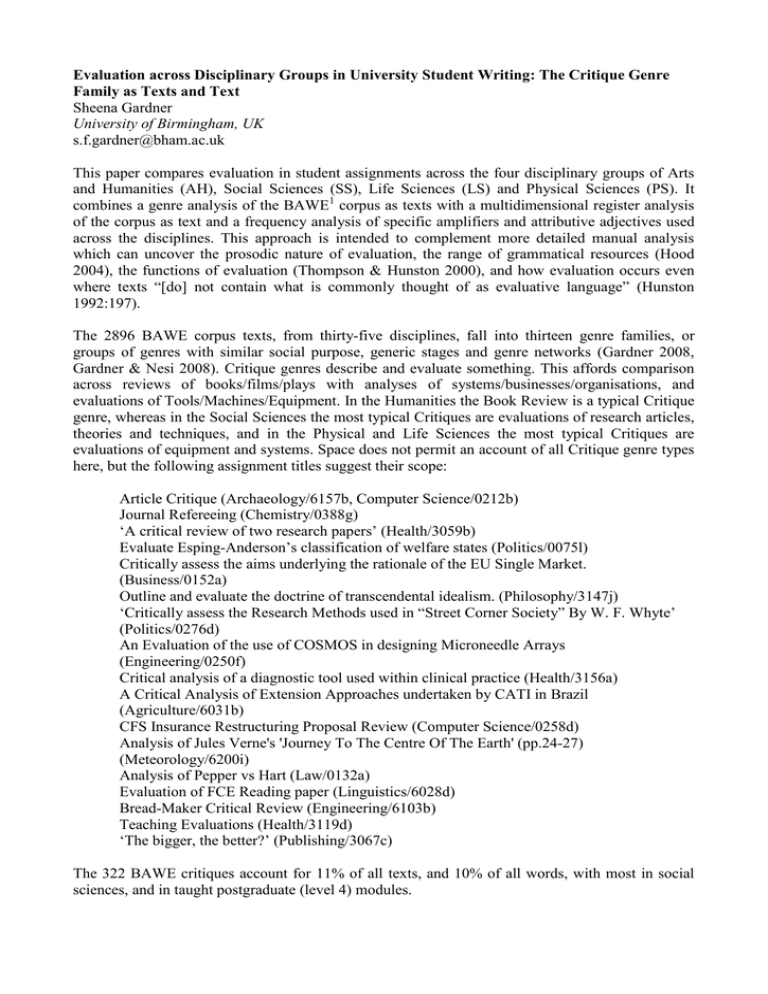
Evaluation across Disciplinary Groups in University Student Writing: The Critique Genre Family as Texts and Text Sheena Gardner University of Birmingham, UK s.f.gardner@bham.ac.uk This paper compares evaluation in student assignments across the four disciplinary groups of Arts and Humanities (AH), Social Sciences (SS), Life Sciences (LS) and Physical Sciences (PS). It combines a genre analysis of the BAWE1 corpus as texts with a multidimensional register analysis of the corpus as text and a frequency analysis of specific amplifiers and attributive adjectives used across the disciplines. This approach is intended to complement more detailed manual analysis which can uncover the prosodic nature of evaluation, the range of grammatical resources (Hood 2004), the functions of evaluation (Thompson & Hunston 2000), and how evaluation occurs even where texts “[do] not contain what is commonly thought of as evaluative language” (Hunston 1992:197). The 2896 BAWE corpus texts, from thirty-five disciplines, fall into thirteen genre families, or groups of genres with similar social purpose, generic stages and genre networks (Gardner 2008, Gardner & Nesi 2008). Critique genres describe and evaluate something. This affords comparison across reviews of books/films/plays with analyses of systems/businesses/organisations, and evaluations of Tools/Machines/Equipment. In the Humanities the Book Review is a typical Critique genre, whereas in the Social Sciences the most typical Critiques are evaluations of research articles, theories and techniques, and in the Physical and Life Sciences the most typical Critiques are evaluations of equipment and systems. Space does not permit an account of all Critique genre types here, but the following assignment titles suggest their scope: Article Critique (Archaeology/6157b, Computer Science/0212b) Journal Refereeing (Chemistry/0388g) „A critical review of two research papers‟ (Health/3059b) Evaluate Esping-Anderson‟s classification of welfare states (Politics/0075l) Critically assess the aims underlying the rationale of the EU Single Market. (Business/0152a) Outline and evaluate the doctrine of transcendental idealism. (Philosophy/3147j) „Critically assess the Research Methods used in “Street Corner Society” By W. F. Whyte‟ (Politics/0276d) An Evaluation of the use of COSMOS in designing Microneedle Arrays (Engineering/0250f) Critical analysis of a diagnostic tool used within clinical practice (Health/3156a) A Critical Analysis of Extension Approaches undertaken by CATI in Brazil (Agriculture/6031b) CFS Insurance Restructuring Proposal Review (Computer Science/0258d) Analysis of Jules Verne's 'Journey To The Centre Of The Earth' (pp.24-27) (Meteorology/6200i) Analysis of Pepper vs Hart (Law/0132a) Evaluation of FCE Reading paper (Linguistics/6028d) Bread-Maker Critical Review (Engineering/6103b) Teaching Evaluations (Health/3119d) „The bigger, the better?‟ (Publishing/3067c) The 322 BAWE critiques account for 11% of all texts, and 10% of all words, with most in social sciences, and in taught postgraduate (level 4) modules. Critique Critique 16 16 14 14 12 12 10 8 Percent Percent 10 Critique 8 6 6 4 4 2 2 0 Critique 0 1 2 3 4 Arts and Humanities Level (year) of study Life Sciences Physical Sciences Social Sciences These higher proportions reflect the frequency of Critiques in research methods modules, and the contested nature of knowledge in the Social Sciences. The multidimensional analysis of Critiques (Gardner 2008, Nesi this volume) suggests a trend along one Dimension only, Informational-Involved: Critiques become more „informational‟ with each successive year of study, while Critiques in the Life Sciences and Social Sciences are most informational. Biber et al. (2002b:48) found a similar informational trend in textbook years, showing increases in nouns, word length, prepositions, type/token ratio and attributive adjectives with years (ibid:15). Exactly how progress along the Informational-Involved Dimension is reflected in the language of Critiques requires further investigation, but an obvious place to start is with the use of attributive adjectives across the disciplines. Involved vs Informational Dimension 0 1 2 3 4 -5 AH -10 LS PS SS -15 all -20 -25 Level Biber et al. (2002a:200) found that good, best, right, important, simple and special were frequent attributive adjectives in academic prose; Thetela (1997:114) identifies significant, important, interesting, remarkable as frequent in research articles. In the BAWE corpus as a whole particularly frequent collocates of very (+/-5) were found to be different-important in Arts and Humanities, important-similar-small-little-useful in Life Sciences; difficult-important-limited-little-gooddifferent in Social Sciences, and useful-accurate-important-simple in Physical Sciences. Interestingly SS is the only disciplinary group with frequent negative evaluation (difficult, limited). Examples of these in context from specific disciplines can be easily found using the corpus query tool SketchEngine (www.sketchengine.co.uk) Important, significant and useful are in the top ten most frequent collocates of very in all four disciplinary groups. They are used with the following collocates in Critiques (F>5, MI>4): Important aspect, factor, element, Significant Impact, reduction, difference*, Useful Tool, information, model, consideration, implication, role, issue, tool, objective, step, technique, principle, thing, feature, part, development, quality, information, stage, area, point, approach, decision, analysis, question, change, research, study, process, model growth, effect, amount, benefit, source, site, analysis, method, change, role, figure, development, influence, research, term, evidence, result, factor, number, cost, increase Important is the most frequent, and widespread, of the three, occurring in over 200 Critiques across 28 disciplines. Its collocation with aspect, feature, element and others suggests a pervasive analytical perspective to evaluation. In contrast, significance is associated with impact and change in size, where usefulness is associated with tools and information. Figure 4 shows how the terms important and significant are relatively most frequent in SS, whereas useful is relatively more frequent in PS. 160 140 120 100 relative % 80 60 40 20 useful signficant 0 SS LS important PS AH Importance is attached to a wide range of entities, across all disciplines, and frequently to analytical features: aspects, factors, elements, roles and issues; Significance is attached to change and growth features: impact, effect, change, results, reduction, and growth; where usefulness is attached both to tools and to information. Explicit evaluation involving the three adjectives is most evident in SS, and least evident in AH, but of course this does not necessarily mean that Critiques in AH do not use evaluative language as there are many alternative, more topic specific ways of expressing evaluation. Biber, D., S. Conrad and G. Leech. 2002a Longman Student Grammar of Spoken and Written English. Biber, D., S. Conrad, R. Reppen, P. Byrd and M. Helt. 2002b. Speaking and writing in the university: A multidimensional analysis. TESOL Quarterly, 36/1:9-49. Gardner, S. 2008. Integrating ethnographic, multidimensional, corpus linguistic and systemic functional approaches to genre description: an illustration through university history and engineering assignments. In E. Steiner and S. Neuman (eds) Proceedings of the 19th European Systemic Functional Linguistics Conference and Workshop, Universität des Saarlandes, Saarbrücken, July 2007. Gardner, S. and H. Nesi. 2008. A new categorisation of university student writing tasks. Paper presented at conference on Language Issues in English-medium Universities: A Global Concern, University of Hong Kong, China. 18-20 June 2008, available at http://www.hku.hk/clear/conference08/programme.html Hood, S. 2004. Appraising Research: Taking a stance in academic writing. Unpublished PhD Faculty of Education University of Technology, Sydney. Hunston, S. 1994 Evaluation and organisation in a sample of academic written discourse. In Malcolm Coulthard (ed.) Advances in Written Text Analysis. London: Routledge. Nesi, H. (this volume) Multidimensional Analysis of University Student Writing Thetala, P. 1997. „Evaluated entities and parameters of value in academic research articles‟. English for Specific Purposes, Vol. 16 No. 2 (101-118). Thompson, G. and S. Hunston. 2000. Evaluation: An Introduction. In S. Hunston and G. Thompson (eds) Evaluation in Text. Oxford: Oxford University Press. 1. The project An investigation of genres of assessed writing in British Higher Education, which was funded by the Economic and Social Research Council (project number RES-000-23-0800) from 2004 to 2007, includes the development of the British Academic Written English corpus at the Universities of Warwick, Reading and Oxford Brookes under the directorship of Hilary Nesi and Sheena Gardner (formerly of the Centre for English Language Teacher Education, Warwick), Paul Thompson (Department of Applied Linguistics, Reading) and Paul Wickens (Westminster Institute of Education, Oxford Brookes).
